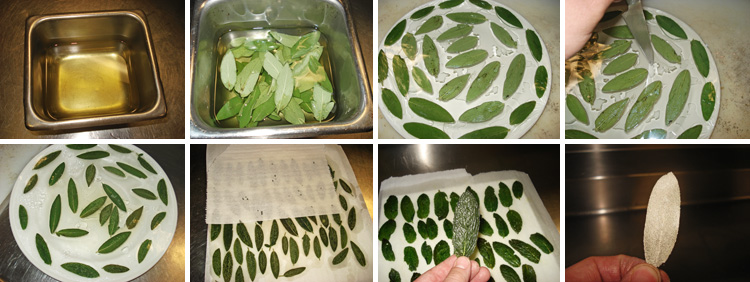How To Cook Risotto
Risotto is made with Italian-grown Arborio rice. Arborio has rice kernels that are shorter and fatter than other short-grained rice. The kernels contain a high amount of starch, which is what gives risotto its creamy texture. A common misconception is that cream is added to risotto to give it its creamy texture. Classic risotto, in fact, does not contain any cream. Although adding cream is not the worst of culinary sins, it should be added for richness and flavor, not texture. More on this later...
Risotto Technique
-
Start by sweating shallots in a pan with butter and a little salt, until the shallots are soft and tender. For every 1lb of Arborio rice, you will need to use 2-4oz of butter and sweat about 5 shallots.
-
Add the Arborio rice to the pan, stirring with a wooden spoon until the rice kernels are evenly coated with the butter; Do not brown.
-
Note: You don’t have to use butter for your fat. Any fat will do such as pork, duck, or olive oil - butter is just the classical choice. Take into consideration the flavor profile the fat you choose will impart on the finished risotto. As far as most chefs are concerned, butter is KING!
-
Once the rice is sautéed and coated evenly, add hot stock or water that is simmering in a separate pot, one ladle at a time.
-
Note: For every cup of Arborio rice, you will need at least 3 cups of hot stock or other liquid
-
Very gently simmer rice while constantly stirring.
-
Once the rice absorbs the first ladle of liquid, add more, one ladle at a time, stirring constantly. Repeat until the Arborio rice is soft but still “al dente”, and the starches have released from the kernel making the risotto nice and creamy.
-
Finish by stirring in butter and freshly grated parmesan.
If at all possible, use the correct corresponding stock of the protein you will be serving with the risotto. For example, if you will be serving it with fish, use a fish stock; if you will be serving your risotto with beef, use veal stock, etc. If the risotto is served as the entrée itself, use whatever liquid you feel is appropriate for your desired finished dish.
To Cream or Not To Cream
The debate among chefs on whether or not to finish their risotto with cream is a passionate one. Traditionally speaking, risotto is not finished with cream; instead, the creaminess is lovingly coaxed out of the starchy kernels of the Arborio rice. Here are some things you need to consider when making the decision “To Cream or Not To Cream.”
-
If you add cream for a creamy texture, I apologize, but you are sorely misguided. The creamy texture of your risotto should come from the Arborio rice itself. Remember, you are making risotto, not rice with alfredo sauce.
-
If you add cream for extra body and fat content (fat is always welcomed by the human palate), then you are adding it for the right reason.
-
Take into consideration that when you add fat to anything, it coats the palate, muting other flavors. The more subtle flavors of your risotto will be less detectable, so consider adding more salt or any other predominant seasoning or flavor you want to manifest in your risotto.
-
If you are serving the risotto with a more delicate protein, such as fish or poached poultry, I would leave the cream out. It may make the risotto too heavy, and as good as the risotto is by itself, your starch should never overpower your protein, it should always add to it.
-
When adding cream to a risotto, some chefs will whip it into a stiff whipped cream and then fold it in. This will not only give the risotto a rich flavor, but also a light and creamy texture.
Restaurant Risotto
Great risotto is a labor of love that can’t be rushed or faked. I’ve seen many different recipes for “quick and easy” risottos, some that even use a microwave (gasp!). Such culinary sins shall not be condoned on this site. However, did you think that the amazing black truffle risotto with wild forged mushrooms you had at Restaurant Fancy Pants the other night was made to order? Not likely.
With a cooking time of at least 25 minutes or more, restaurant chefs would never be able to make risotto “to order”. What follows is a basic restaurant technique for “pre-shifting” risotto. This will allow you to cook it ahead of time, and finish it “to order”.
-
Begin by starting your risotto with the basic technique stated at the top of this article.
-
Cook the Arborio rice until it starts to soften, but stop just before it becomes truly “al dente”.
-
Pour risotto out onto a buttered baking sheet and spread into a thin and even layer.
-
Cool in your refrigerator.
-
When you’re ready to finish your risotto, say, after your dinner guests have arrived and consumed a couple glasses of good wine, bring your cooking liquid of choice (stock, water, etc.) to a simmer in an appropriately sized sauté pan.
-
Add the par-cooked risotto into the simmering liquid, and use the back of a slotted spoon to break up the individual rice kernels by pressing them down into the pan.
-
Gently simmer and stir until the risotto is reconstituted and becomes “al dente”.
-
Finish with butter, fold in whipped cream (if you dare), season to taste, and add any other flavorings you wish, such as parmesan, truffle oil, etc.
-
Watch your friends marvel at how quickly you were able to make an amazing tasting risotto.

